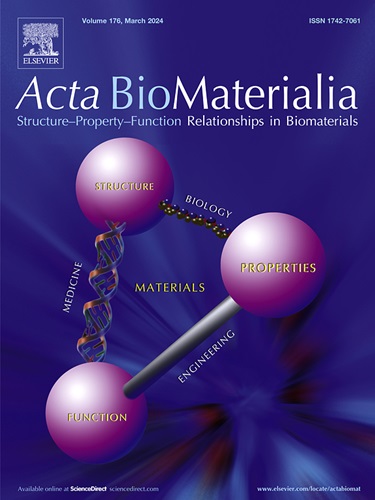Janus hydrogels delivering low-density lipoprotein receptor-related protein 6 inhibitor enhance myocardial repair via m6A-dependent cuproptosis in bama pigs
IF 9.6
1区 医学
Q1 ENGINEERING, BIOMEDICAL
引用次数: 0
Abstract
Copper overload induces a unique form of cell death called cuproptosis via mitochondrial ROS accumulation. Following myocardial infarction (MI), copper ion levels rise significantly in infarcted tissue. Cardiomyocytes, highly sensitive to copper, respond through activation and nuclear translocation of LRP6, which interacts with ALKBH5 to suppress m6A modification of ferredoxin 1 (FDX1), thereby exacerbating copper toxicity. LRP6 also facilitates copper influx, further promoting cuproptosis. High-throughput screening identified chrysin-7-O-glucuronide (C7Og) as a potent LRP6 inhibitor that mitigates cuproptosis without compromising cardiac protective effects. Moreover, a Janus hydrogel enhanced with benzalkonium chloride-modified tannic acid improves tissue adhesion and glucose delivery. A myocardial patch integrating C7Og within this hydrogel significantly reduced infarct size and improved cardiac function in both rat and Bama miniature pig models, highlighting strong translational potential for MI therapy.
Statement of significance
This study uncovers a mechanism of copper-induced cell death, termed cuproptosis, in myocardial infarction (MI). It identifies low-density lipoprotein receptor-related protein 6 (LRP6) as a key regulator of copper influx and cuproptosis, revealing a potential target for mitigating copper toxicity in cardiac tissue. Chrysin-7-O-glucuronide (C7Og), a potent LRP6 inhibitor, offers a promising strategy to prevent LRP6-mediated cell death while preserving its protective role in cardiac function. Encapsulating C7Og in a Janus hydrogel enhances its delivery and adhesion, demonstrating significant efficacy in reducing myocardial damage and improving cardiac function in rat and Bama miniature pig models. This work offers new insights into copper homeostasis and presents a potential therapeutic approach for MI treatment.

传递低密度脂蛋白受体相关蛋白6抑制剂的Janus水凝胶通过m6a依赖性铜化增强巴马猪心肌修复
铜超载通过线粒体ROS积累诱导一种称为铜增生的独特细胞死亡形式。心肌梗死(MI)后,梗死组织中铜离子水平显著升高。心肌细胞对铜高度敏感,通过LRP6的激活和核易位做出反应,LRP6与ALKBH5相互作用,抑制铁氧还蛋白1 (FDX1)的m6A修饰,从而加剧铜毒性。LRP6还能促进铜的内流,进一步促进铜还原。高通量筛选鉴定出菊花素-7- o -葡糖苷(C7Og)是一种有效的LRP6抑制剂,可在不影响心脏保护作用的情况下减轻铜沉降。此外,用苯扎氯铵修饰的单宁酸增强的Janus水凝胶可以改善组织粘附和葡萄糖输送。在该水凝胶中加入C7Og的心肌贴片可显著降低大鼠和巴马微型猪模型的梗死面积,改善心功能,突出了心肌梗死治疗的强大转化潜力。意义声明:本研究揭示了心肌梗死(MI)中铜诱导细胞死亡的机制,称为铜增生。该研究发现低密度脂蛋白受体相关蛋白6 (LRP6)是铜内流和铜沉积的关键调节因子,揭示了减轻心脏组织铜毒性的潜在靶点。C7Og (Chrysin-7-O-glucuronide)是一种有效的LRP6抑制剂,它提供了一种有希望的策略,可以防止LRP6介导的细胞死亡,同时保留其在心功能中的保护作用。在Janus水凝胶中包封C7Og增强了其递送和粘附,在大鼠和巴马微型猪模型中显示了显著的心肌损伤和改善心功能的效果。这项工作为铜稳态提供了新的见解,并为心肌梗死的治疗提供了潜在的治疗方法。
本文章由计算机程序翻译,如有差异,请以英文原文为准。
求助全文
约1分钟内获得全文
求助全文
来源期刊

Acta Biomaterialia
工程技术-材料科学:生物材料
CiteScore
16.80
自引率
3.10%
发文量
776
审稿时长
30 days
期刊介绍:
Acta Biomaterialia is a monthly peer-reviewed scientific journal published by Elsevier. The journal was established in January 2005. The editor-in-chief is W.R. Wagner (University of Pittsburgh). The journal covers research in biomaterials science, including the interrelationship of biomaterial structure and function from macroscale to nanoscale. Topical coverage includes biomedical and biocompatible materials.
 求助内容:
求助内容: 应助结果提醒方式:
应助结果提醒方式:


